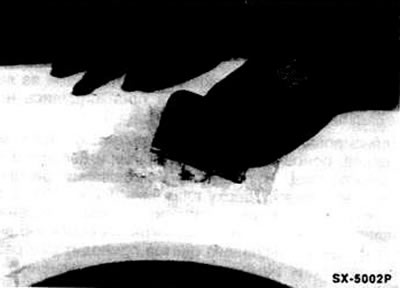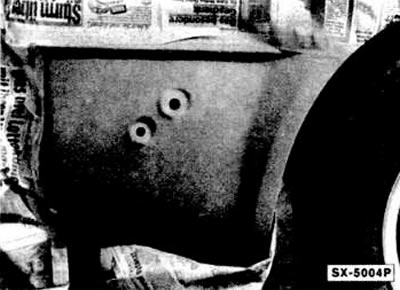Lacquering should be carried out only at temperatures above +12°C, avoiding direct sunlight and wind.
Rust removal
Paste the repair area with adhesive tape so as not to accidentally damage the adjacent varnish.
Use a triangular file or screwdriver and #120 sandpaper to remove visible rust and rust hidden by bubbles.
With sanding paper No. 320, sand in advance the place around the damage in a width of about 1-2 cm to a healthy varnish.
Grind galvanized surfaces of the body, if possible, only to the primer, and not to the galvanized surface.
Applying a corrosion protection primer (Primer)
Wipe the repair area with nitro thinner and remove grease and dust with a clean cloth, let dry.
To avoid further problems, the Primer and the top coat to be applied must be from the same production. Otherwise, the varnish may later blister or shrink.
"Primer" sprayed onto rust-free tin from a distance of 25 cm. To prevent the smallest spray of aerosol from falling on adjacent parts, glue the surface around the repair site with paper and adhesive tape.
Spraying can be repeated after 10-15 minutes. If a putty is required after spraying, the Primer should be allowed to dry.
Putty
There are two types of putty: two-component putty and thin putty. The two-component putty is mixed shortly before processing with a hardener. It causes a rapid hardening of the putty, which can be processed shortly thereafter. This putty is used to level larger body irregularities. Thin putty is decorative, smoothing out small irregularities. It can be applied in several layers. Both types of putty are available in tubes and cans, filling putties are also available in aerosol packaging.
Attention! although the can indicates that the putty can be applied directly to the cleaned tin, just in case, we recommend that you pre-treat the tin with ''Primer" (corrosion protection).
Apply two-component putty to the straightened or fibreglass-reinforced repair area and allow to cure. Follow the putty manufacturer's instructions.
After drying, sand the irregularities by hand or with a superfinishing head. Sanding paper no. 180 should be used for this. Wet sanding paper can be used. In this case, moisten the repair area with a wet sponge, and from time to time pour enough water on the sanding paper during the sanding process.
Finally, thoroughly clean the repair area and let it dry.

Cover the repair area with thin putty using a wide, flexible plastic spatula and let it dry for at least two hours. In places of repair on roundings and contours, the use of a thin putty in an aerosol can is recommended.
Depending on the thickness of the layer, thin putty should dry for 2-3 hours.
Grinding
Sanding paper of various grain sizes is available for sale. The smaller its number, the coarser the grinding. For sanding a two-component putty, grit size from No. 180 to No. 240 is recommended; filler filler and old varnish are sanded with sanding paper No. 360 with moisture. For the final wet sanding before varnishing, sanding paper #600 is recommended.

Sand the prepared puttied place with wet paper No. 360, while constantly squeezing the wet sponge over the sanded place. Immerse the sponge from time to time in clean water and let it soak completely with water.
The special wet sanding paper No. 600 is best suited for the subsequent wet final sanding and can also be used for sanding border varnish and spatter varnish. The remaining microscopic scratches on the top coat are hardly noticeable.
Cleaning
Before applying the lacquer coating, the surface to be sanded and the adjacent lacquer surface about two palms wide must be cleaned of grease and silicone residues. Silicone remover works best for this.
After sanding, thoroughly clean the repair area and cover all adjacent surfaces with newsprint and adhesive tape. When varnishing the fenders, carefully glue the tires and shock absorber.

If possible, always glue the repaired area so that the sprayed surface reaches the nearest decorative strip or the edge of the body, because. on the edge of the coloring always formed streaks of paint. If a relatively smooth transition to a branded varnish is not possible, then glue it at a distance of about the width of two palms from the place of repair.
Spray the floor with water to prevent dust from settling.
Visitor comments